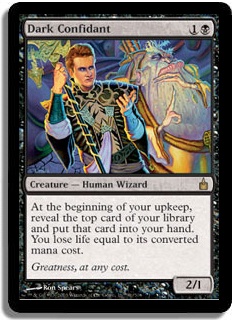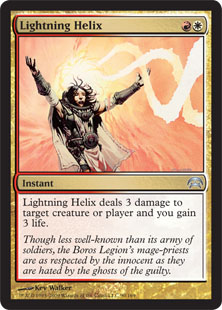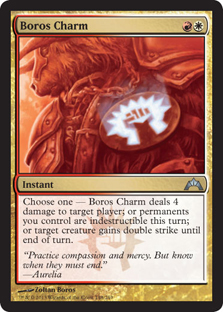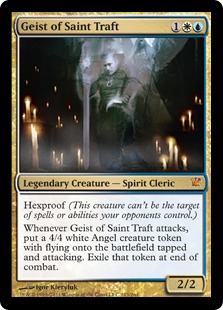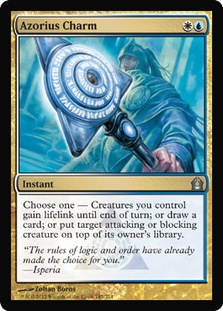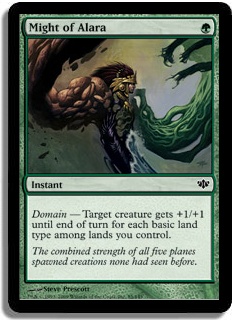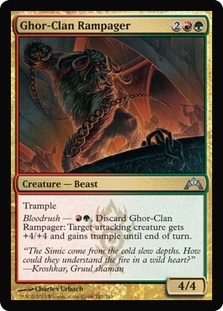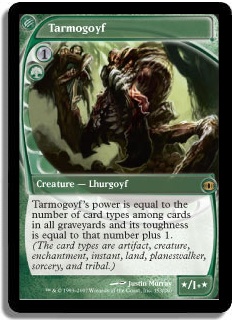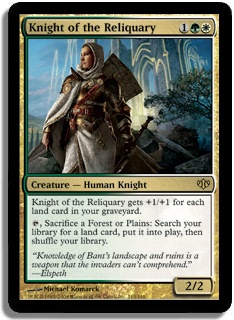Turn 1: “Wild Nacatl, go,” I say to my opponent at my local game store’s Legacy event. After taking a look at my hand, I am feeling pretty good. It contains early pressure in the form of Wild Nacatl, followed by burn and even more threats. I love my chances when it comes to battling in the combat phase! My opponent looks at me and smiles: Swamp, Dark Ritual, Dark Ritual, Lion’s Eye Diamond, Lion’s Eye Diamond, Infernal Tutor (cracking both LED with priority), fetching Infernal Tutor, fetching Ill-Gotten Gains (this actually happened to me and was pre-Mental Misstep), getting back Dark Ritual, LED and Infernal Tutor, playing all three again, finally fetching Tendrils of Agony for 22.
I lose game 1, and game 2 doesn’t go any better. I would love to say after the match that I sat there and had a Teddy KGB moment screaming to my friends, “He beat me. He beat me straight up!” I didn’t feel that way at the time. If anything, I felt like I wanted my money back. Love it or hate it, that’s how Magic works, and some matchups will get the best of you.
During Modern last season, my turn 1 Goblin Guides were greeted by many turn 3 kills by Storm opponents. In fact, my Storm opponents were so used to beating me that as soon as they got paired against me they already have money signs in their eyes! Part of this is my fault. I play what I want to play, and a high percentage of the time it is a deck that is a dog to Storm.
I am more than a little happy that at my last PTQ in Green Bay, I didn’t see a single Storm deck, which is one less problem for Zoo players to worry about. Modern’s recent banning of Seething Song makes Storm not likely to show up any time soon. This makes now the perfect time to try out a number of different aggressive decks. With so many solid card choices in multiple colors and combinations, we can experiment with a number of different builds.
I have had the opportunity to play a lot of Modern and want to share some different Zoo decks that I have been working with and that have been played against me lately. I will be taking a look at the core card from each deck. With so many aggressively costed creatures, hopefully this information will be useful to you when deciding which creatures to include in your own version of the deck or determining which deck you want to play.
Dark Zoo
Creatures (25)
- 3 Grim Lavamancer
- 3 Dark Confidant
- 4 Figure of Destiny
- 4 Goblin Guide
- 4 Steppe Lynx
- 3 Vexing Devil
- 4 Deathrite Shaman
Lands (19)
Spells (15)
Sideboard

I recently played this at a PTQ to some success, ending with a 6-2 record. I was very pleased with how the deck performed, losing two very close matches to Tron and Scapeshift. I was extremely happy with what black added to the deck. This is the version I enjoy the most when it comes to aggressive decks in Modern.
I think it’s worth noting which cards stood out for me during my testing and tournament play.
Deathrite Shaman: I recently started testing it in the deck and played it at the PTQ. It was easily one of the best cards in the entire deck. Not only did give me reach and mana acceleration, but one thing I realized when playing a three-colored deck in Modern is that shocklands hurt! Splashing the one Stomping Ground was well worth it, allowing me to offset the life loss that the fetchlands and shocklands did.
Dark Confidant: Bob was the reason why I wanted to add black to the deck in the first place. One thing you might notice if you compare this list to the list in my last article is that I cut the count from four to three. I found that you only want one Dark Confidant a game, as drawing multiples or topdecking one late could cost you in a close game. Not to take anything away from Dark Confidant, as he is easily one of the best creatures in the deck.
Lighting Helix: This not only gave me the reach I needed, but it caused my opponents to miscalculate my life total and make poor attacks. Instant speed life gain and damage that my opponents are not aware of in a close game can be the difference between winning and losing. At the PTQ, my opponent double Goblin Grenaded me to do exactly lethal damage to end the game. I responded by casting Lighting Helix to gain enough life to give me the extra damage for lethal on my turn because he cleared his board of blockers.
Boros Charm: I closed a number of games with this card. It’s amazing how much four damage for two mana helps your math when trying to deal lethal. Boros Charm does a lot of work to help you survive Pyroclasm and various other sweepers. Even if my opponent was able to follow up with another sweeper the very next turn, the damage dealt the turn after I Charmed was often the difference between winning and losing. I have been very impressed with how effective Boros Charm has been, and I see it being a staple in red/white decks for a long time.
U/W/R Zoo
Creatures (19)
Lands (22)
Spells (21)
Sideboard

Blue offers an interesting dynamic, and this deck probably has the better long game compared to the other Zoo decks. A few friends of mine have been playing Delver-based versions of U/W/R, but this is how I would approach the deck.
Geist of Saint Traft: Geist has been showing up a lot in aggressive strategies because he represents so much damage with each swing and on top of that has hexproof. If he connects once, he does a super-efficient six damage for three mana. Any damage beyond that is icing on the cake.
Snapcaster Mage: Getting Snapcaster is another big reason to go the blue direction, giving you additional combat tricks and reach with your burn spells. Snapcaster makes you feel like you never run out of your best spells. Just thinking about a Snapcastered Boros Charm puts a big smile on my face.
Azorius Charm: I know many of you have had great experiences with this card in Standard, screwing over your opponent’s attack or have watched some of the game’s best players use it as a way to draw a card to ensure they hit much needed land drops during the coverage of Pro Tour Gatecrash. If both of those options aren’t good enough, the last of Azorius Charm’s abilities that tends to get overlooked is the first one listed on the card. Creatures (plural, meaning all your creatures) you control gain lifelink. If you’re looking for a way to get yourself back in a game or are looking to put yourself far ahead of a burn deck or Zoo opponent, Azorius Charm is definitely a card to consider when designing your deck.
Rampage Zoo
Creatures (26)
- 3 Kird Ape
- 4 Tarmogoyf
- 3 Knight of the Reliquary
- 4 Goblin Guide
- 4 Steppe Lynx
- 4 Deathrite Shaman
- 4 Ghor-Clan Rampager
Lands (22)
Spells (12)

Some people have incorporated a little bloodrush in their Zoo decks. I can definitely see some potential in these builds. This type of deck intrigues me. It is a little less about the burn and more about creatures and board presence. With all the fetchlands, Knight of the Reliquary can get pretty big pretty fast. A Bloodrushed Knight or Knight double striking can end the game quickly.
Might of Alara: This card is interesting. I have seen it pop up in a few lists, but I’m not sure if I am sold on it yet. There is no denying its mana efficiency. This card can turn into four damage for one mana very easily. If anything, it can be a sweet combat trick your opponent is not expecting.
Ghor-Clan Rampager: No, this isn’t Limited, but this guy can pack a punch. I think if the Charms have taught us anything it is the more options your cards have the better. This guy can be a blow out in the red zone or a 4/4 trampler for four mana. It does seem unique and fun; I am curious to see if he continues to show up in aggro lists moving forward.
Tarmogoyf: Probably the best reason to go green. One thing I’ve noticed with Zoo and Burn decks is they tend to get Tarmogoyf’s power and toughness up sooner rather than later.
Knight of the Reliquary: I think Knight is a little underrated in Modern currently. We can make great use of her, whether it’s fetching the right colored mana or grabbing a Treetop Village, Kessig Wolf Run, or Ghost Quarter. Like I mentioned earlier, she is also an incredible attacker, and upping her power or toughness isn’t much of a problem with all the fetchlands.
I don’t think there has been a better time to play aggro deck in Modern. While the format is still finding itself, I believe it is one of the best ways to approach the format. With so many potent spells and creatures in every color of Magic, you can basically build your deck however you see fit. At my next PTQ, I plan on returning to the dark side and playing my Dark Zoo list. It does everything I want to do in Magic.
I look forward seeing what decks people come up with in this new Modern environment. The format seems pretty wide open to me, which is part of the reason it has caught my attention.
Thanks for reading!
@Grichtsmeier on Twitter
Gene Richtsmeier on Facebook


